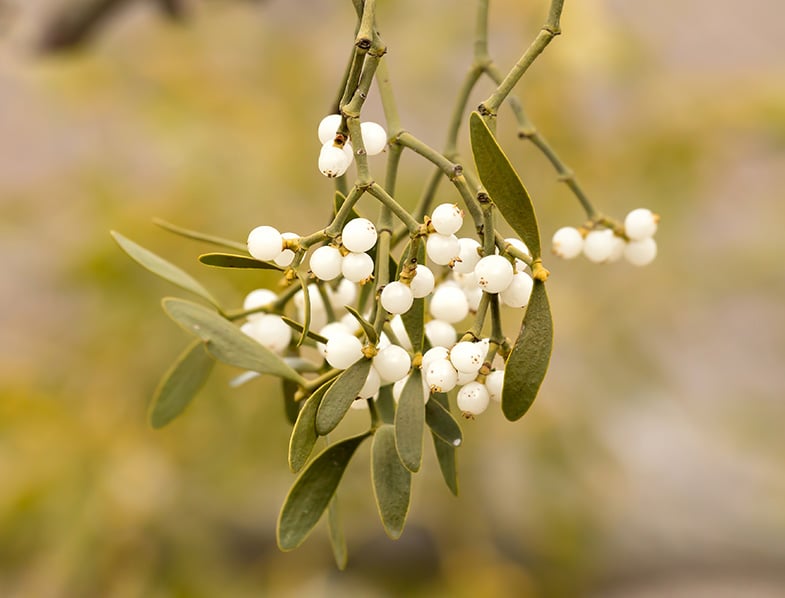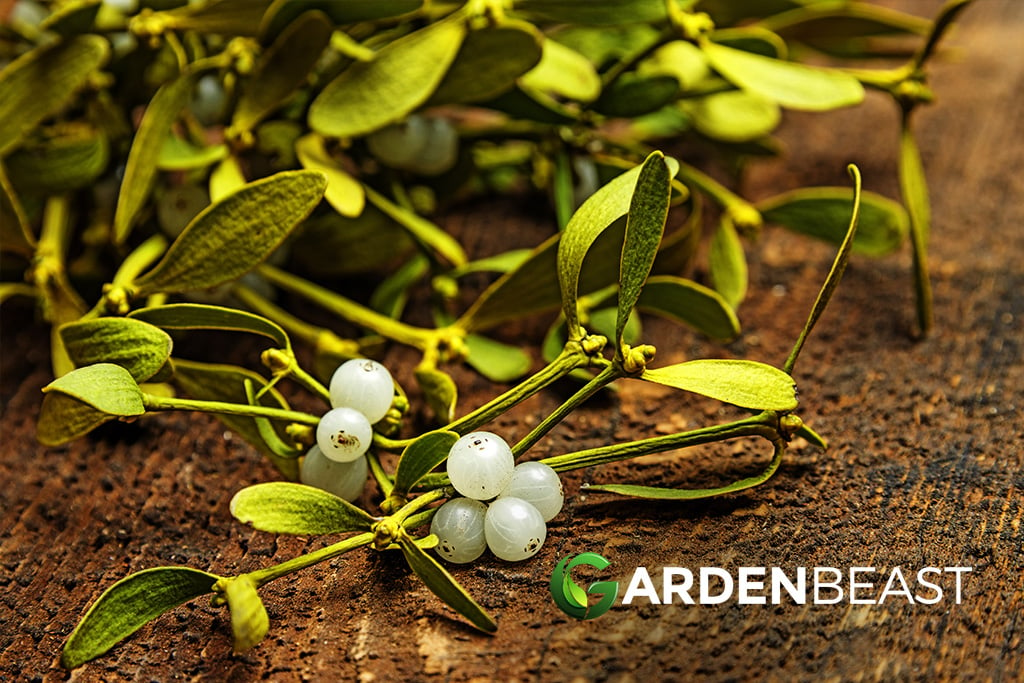The winter holidays will be here in the blink of an eye and do you know what comes next?
Decoration time! And we know that every plant-lover wants something new to enjoy every year. From the well-known Poinsettias to other festive-looking ornamental houseplants, there are so many beauties to choose from. But we warmly recommend a plant that plays a big part in Christmas symbology and decoration.
Viscum Album, commonly referred to as Common Mistletoe, European Mistletoe, or just Mistletoe, is a species of obligate hemiparasitic shrubs in the Santalaceae family. Mistletoe plants can be found in the British Isles, southern and western Asia, and many regions of Europe.
These Christmas plants are eye-catching and have always attracted some popularity and attention along their way. They have significant representations in European mythology, customs, and legends.
In pre-Christian European cultures, these shrubs were considered a divine representation of the male essence, a symbol for romance, vitality, and fertility. Moreover, it is believed that Celtic people used to view Mistletoe plants as sacred when seen growing on an oak tree, which is a very rare host even today.

Ancient Greeks and Romans also had an interesting relationship with this alluring shrub. In Greek mythology, it is said that Mistletoe was the Golden Bough of Aeneas and many heroes used it to access the underworld. Roman people, on the other hand, hung the plant over doorways for protection and associated it with love, peace, and understanding.
According to an old Christmas habit, two people who meet under a Mistletoe were bound to kiss. The oldest known case of kissing under the Mistletoe dates somewhere around the 16th century in England. This tradition may have Scandinavian origins and is still practiced nowadays in many regions around the world.
About Mistletoe
- In Europe, a Mistletoe branch is a must-have adornment during the holidays. As a houseplant, this shrub can be grown both indoors and outdoors without any trouble.
- Their branches are very common in various landscape decorations, especially during Christmas. They can be used in colorful combinations near Poinsettias, Frosty Ferns, roses, pine cones, fir branches, and Amaryllis.
- Mistletoe plants are used as an ingredient to produce a pomace brandy liquor called biska. This drink is highly popular in Istra, Croatia.
- They have a good reputation in alternative and traditional medicine. Their leaves and young twigs are used in concoctions that can treat respiratory and circulatory system problems.
- Rudolf Steiner, the founder of Anthroposophy, was the first man to use Mistletoe extract as a treatment for cancer. There is still little evidence of Mistletoe’s health benefits, so we don’t recommend consuming this plant.
- The United Kingdom town of Tenbury Wells holds a festival in honor of Mistletoe plants every year and even crowns a ‘Mistletoe Queen’.
- The sticky juice that can be found in Mistletoe berries worked as an excellent adhesive trap for birds and animals. This product is commonly known as birdlime.
- These shrubs are an important source of food for some mammals that eat their leaves and fruits. They are also used for nesting purposes by many birds and small animals.
- If their berries are consumed by humans or pets in a concentrated form, Mistletoe plants can be potentially fatal. However, some birds like mistle thrushes or blackcaps are immune to their toxic berries.

Mistletoe Features: An Overview
- These shrubs belong to the Viscum genus that contains about 70 to 100 species of mistletoes. The most popular cultivars include V. Album, V. Capense, V. Cruciatum, V. Minimum, and V. Rotundifolium.
- Mistletoe plants climb on other trees and their stems can reach between 12 and 39 inches (30-100 cm) in height.
- With a relatively slow-growing habit, these shrubs form clumps as large as 5 feet (1.5 m) in width. They prefer to nest in the crowns of broad-leaved trees.
- They produce leathery, strap-shaped, and yellow to green leaves that grow in opposite pairs on long dichotomous branches.
- Their leaves usually grow from 0.79 to 3.15 inches (2-8 cm) long and 0.31 to 0.98 inches (0.8-2.5 cm) in diameter.
- Mistletoe plants exhibit cute tiny bloomings that remain unnoticed in most cases. Their flowers come in various shades and mixes of yellow and green.
- These plants will bear white or yellow fruits called berries. Typically, they contain only one seed that is surrounded by a sticky and viscous fruit pulp, with few specimens that can present more seeds than others.
- Other subspecies of Mistletoe plants are also popular during the holidays and they differ from the traditional Mistletoe in leaf shape, size, and fruit color. These subspecies are known as V. Album subsp. Abietis, Album, Austriacum, Meridianum, Creticum, and Coloratum.

Growing Mistletoe
Like all obligate parasites, Mistletoe plants are organisms that cannot complete their life-cycle nor reproduce properly without a suitable host. They are usually extracting some water and nutrients from several host species of trees, such as apple, lime, poplar, hawthorn, and conifers. Once you find the perfect host for your Mistletoe plant, there will be no extra effort on your part when growing and caring for it.
Mistletoe seeds can be grown in a container with small potted trees. They will take nutrients and lots of moisture from the host plant, so you must choose wisely. Many gardeners use Orchard apples as hosts because they can meet your Mistletoe needs. You will see the best results when the planted seeds are fresh and harvested between March and April.
Planting Mistletoe
When first planting the Mistletoe seeds, fill a pot with fresh all-purpose potting soil mixed with large amounts of peat. Sow as many seeds as you wish and mist the soil until it becomes damp. Cover the pot with plastic wrap to improve humidity and place it in a bright and warm location. The seeds will require several months to germinate.
As soon as you notice some grown-up seedlings with a few leaves, you can transplant them to your chosen host tree. Make a hole in the tree’s bark, place the seedlings into it, and add some damp moss to improve stability. You will need to mist the planting region regularly to keep it moist until the seedlings are perfectly attached to the host.

These plants will be happy as long as their host is healthy and can provide them with whatever they need. There is more chance for the host to suffer than the Mistletoe parasite, so you must watch their relationship closely to understand what they do or do not need.
Mistletoe plants love lots of bright and direct light daily. If you grow them outdoors, they must be situated quite high in the tree host to be exposed to plenty of full sunlight. However, they can handle well some filtered light or partial shade if their host grows too big. Indoors, you should place them in a sunny location, such as near a south-facing window.
When it comes to temperatures, they are very hardy shrubs that can survive even in extreme conditions. Mistletoe plants will do just fine in temperatures that drop until -40 °F (-40 °C), but you will need to worry about their host trees more.
The host may get exhausted once in a while, as your Mistletoe will steal all his vital energy. You can help the tree to remain vigorous with nice regular feedings. Look for fertilizers that work best for your host tree and apply them in spring to give it a boost.
- Shipping products Internationally
- We are selling seeds only
- It is not possible to return the goods
- The number of packages is 1
- ✅ ABOUT PRODUCT- This package contains New Fresh Mistletoe Plant Seeds Generic , SEEDS ONLY, no live plants.The photos show are the mature plant in the future, not the actual plant you will receive
- ✅ PREMIUM TREE SEED MIXTURES -Premium Seed Mix is a blend of high quality ingredients and fertilisers designed specifically for germinating and growing from seeds with vigorous
- ✅QUALITY - All seeds packaged by Seed Needs are intended for the current and the following growing seasons. All seeds are stored in a temperature controlled facility that is free of significant amounts of moisture.
- ✅GERMINATION - Seed Needs packets contain some of the freshest seed available. Direct from the growers. If sown correctly, you will begin seeing results in only a matter of days
- ✅ REACH US -If you do not satisfy with the products, please do not leave negative/neutral feedback. You can contact us for solution. We will try our best to fix the problem as soon as possible
- Botanical Name: Viscum album L.
- 1 pound bulk bag (16 ounces)
Last update on 2024-09-19 / Affiliate links / Images from Amazon Product Advertising API
Watering Mistletoe
The secret with these shrubby climbers stays in how good you are taking care of their host tree. Water-wise, you must keep the soil in which the host is planted constantly moist. You should be very careful when choosing a host for your Mistletoe, as it must be one that is pretty thirsty to avoid over-watering.
Inspect your plants regularly and look for common patterns to understand their basic needs. Mistletoe plants will extract lots of water from their hosts, so it may be necessary to provide them with plenty of water. When the soil feels slightly dry to the touch, this is the ideal time to water your trees until the soil is damp.

Propagating Mistletoe
If you have planted and grown your Mistletoe plants from seeds, you are already a master in propagation techniques. How so? Well, they are also propagated through seeds without any major differences. The seeds can be collected from their fruits in February or early spring, but you should know that your Mistletoe will bear fruits only after four or five years from planting.
Take some berries from the branches and pinch them open to extract their seeds. You can propagate these plants using the same method as for planting or by simply attaching the seeds to the host. Make sure you leave only a bit of pulp on the seeds to help them stick to the tree. For optimal results, you must use fresh berries that appear white and mature enough.
Look for branches that are at least 8 inches (20 cm) long and stick the seeds to them. You can also mark the spots where you place them to know exactly where to look for small Mistletoes. If the seeds are planted in February, you should notice tiny stems with no leaves after one or two months.
In Conclusion
Holidays are so close that you surely wouldn’t want to miss the chance to get one of these festive-looking Mistletoe shrubs. They are pretty easy to grow and care for as long as you pay attention to their host’s needs. With their vast history and cute appearance, Mistletoe plants are a must-have in your Christmas decorations and can be also gifted to your friends and family.
Don’t forget to kiss your loved one under the mistletoe for good luck and let us know if you plan on growing your own mistletoe shrub!



